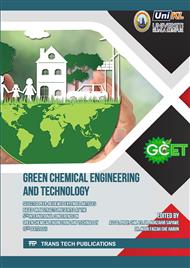[1]
Aziz, K., Aziz, F., Mamouni, R., Aziz, L., & Saffaj, N. (2022). Engineering of highly Brachychiton populneus shells@ polyaniline bio-sorbent for efficient removal of pesticides from wastewater: Optimization using BBD-RSM approach. Journal of Molecular Liquids, 346, 117092.
DOI: 10.1016/j.molliq.2021.117092
Google Scholar
[2]
Mohd Faizal, A. N., Putra, N. R., & Ahmad Zaini, M. A. (2022). Scylla Sp. Shell: a potential green adsorbent for wastewater treatment. Toxin Reviews, 1-10.
DOI: 10.1080/15569543.2022.2039201
Google Scholar
[3]
Tamjidi, S., & Ameri, A. (2020). A review of the application of sea material shells as low cost and effective bio-adsorbent for removal of heavy metals from wastewater. Environmental Science and Pollution Research, 27(25), 31105-31119.
DOI: 10.1007/s11356-020-09655-7
Google Scholar
[4]
Gulati, K., Abdal-hay, A., & Ivanovski, S. (2022). Novel Nano-Engineered Biomaterials for Bone Tissue Engineering. Nanomaterials, 12(3), 333.
DOI: 10.3390/nano12030333
Google Scholar
[5]
Morris, J. P., Backeljau, T., & Chapelle, G. (2019). Shells from aquaculture: a valuable biomaterial, not a nuisance waste product. Reviews in Aquaculture, 11(1), 42-57.
DOI: 10.1111/raq.12225
Google Scholar
[6]
Zairin, D. A., & Phang, S. W. (2018). Calcination time and temperature effect on natural hydroxyapatite obtained from fish bones for bone tissue engineering. Journal of Engineering Science and Technology, 39, 51.
Google Scholar
[7]
Yelten-Yilmaz, A., & Yilmaz, S. (2018). Wet chemical precipitation synthesis of hydroxyapatite (HA) powders. Ceramics International, 44(8), 9703-9710.
DOI: 10.1016/j.ceramint.2018.02.201
Google Scholar
[8]
Santhosh, S., & Prabu, S. B. (2013). Thermal stability of nano hydroxyapatite synthesized from sea shells through wet chemical synthesis. Materials Letters, 97, 121-124.
DOI: 10.1016/j.matlet.2013.01.081
Google Scholar
[9]
Sebti, S., Tahir, R., Nazih, R., Saber, A., & Boulaajaj, S. (2002). Hydroxyapatite as a new solid support for the Knoevenagel reaction in heterogeneous media without solvent. Applied Catalysis A: General, 228(1-2), 155-159.
DOI: 10.1016/s0926-860x(01)00961-9
Google Scholar
[10]
Yu, X., Wen, Z., Li, H., Tu, S. T., & Yan, J. (2011). Transesterification of Pistacia chinensis oil for biodiesel catalyzed by CaO–CeO2 mixed oxides. Fuel, 90(5), 1868-1874.
DOI: 10.1016/j.fuel.2010.11.009
Google Scholar
[11]
Wong, Y. C., Tan, Y. P., Taufiq-Yap, Y. H., Ramli, I., & Tee, H. S. (2015). Biodiesel production via transesterification of palm oil by using CaO–CeO2 mixed oxide catalysts. Fuel, 162, 288-293.
DOI: 10.1016/j.fuel.2015.09.012
Google Scholar
[12]
Shariffuddin, J. H., Jones, M. I., & Patterson, D. A. (2013). Greener photocatalysts: Hydroxyapatite derived from waste mussel shells for the photocatalytic degradation of a model azo dye wastewater. Chemical engineering research and design, 91(9), 1693-1704.
DOI: 10.1016/j.cherd.2013.04.018
Google Scholar
[13]
Afshar, A., Ghorbani, M., Ehsani, N., Saeri, M. R., & Sorrell, C. C. (2003). Some important factors in the wet precipitation process of hydroxyapatite. Materials & Design, 24(3), 197-202.
DOI: 10.1016/s0261-3069(03)00003-7
Google Scholar
[14]
Nanda, S., Azargohar, R., Dalai, A. K., & Kozinski, J. A. (2015). An assessment on the sustainability of lignocellulosic biomass for biorefining. Renewable and Sustainable Energy Reviews, 50, 925-941.
DOI: 10.1016/j.rser.2015.05.058
Google Scholar
[15]
González-García, S., Gomez-Fernández, Z., Dias, A. C., Feijoo, G., Moreira, M. T., & Arroja, L. (2014). Life Cycle Assessment of broiler chicken production: a Portuguese case study. Journal of cleaner production, 74, 125-134.
DOI: 10.1016/j.jclepro.2014.03.067
Google Scholar
[16]
Boguski, T.K., Hunt, R.G., Cholakis, J.M., Franklin, W.E., 1996. LCA methodology. In: Curran, M.A. (Ed.), Environmental Life-cycle Assessment. Library of Congress Cataloging-in-publication Data, pp.15-33.
Google Scholar
[17]
Rebitzer, G., Ekvall, T., Frischknecht, R., Hunkeler, D., Norris, G., Rydberg, T., Schmidt, W.P., Suh, S., Weidema, B.P. and Pennington, D.W., 2004. Life cycle assessment: Part 1: Framework, goal and scope definition, inventory analysis, and applications. Environment international, 30(5), pp.701-720.
DOI: 10.1016/j.envint.2003.11.005
Google Scholar
[18]
Kuriyavar, S. I., Vetrivel, R., Hegde, S. G., Ramaswamy, A. V., Chakrabarty, D., & Mahapatra, S. (2000). Insights into the formation of hydroxyl ions in calcium carbonate: temperature dependent FTIR and molecular modelling studies. Journal of Materials Chemistry, 10(8), 1835-1840.
DOI: 10.1039/b001837f
Google Scholar
[19]
Galván-Ruiz, M., Hernández, J., Baños, L., Noriega-Montes, J., & Rodríguez-García, M. E. (2009). Characterization of calcium carbonate, calcium oxide, and calcium hydroxide as starting point to the improvement of lime for their use in construction. Journal of Materials in Civil Engineering, 21(11), 694-698.
DOI: 10.1061/(asce)0899-1561(2009)21:11(694)
Google Scholar
[20]
Rivera, E. M., Araiza, M., Brostow, W., Castano, V. M., Dıaz-Estrada, J. R., Hernández, R., & Rodrıguez, J. R. (1999). Synthesis of hydroxyapatite from eggshells. Materials Letters, 41(3), 128-134.
DOI: 10.1016/s0167-577x(99)00118-4
Google Scholar
[21]
Khoo, W., Nor, F. M., Ardhyananta, H., & Kurniawan, D. (2015). Preparation of natural hydroxyapatite from bovine femur bones using calcination at various temperatures. Procedia Manufacturing, 2, 196-201.
DOI: 10.1016/j.promfg.2015.07.034
Google Scholar
[22]
Lofrano, G., Carotenuto, M., Libralato, G., Domingos, R.F., Markus, A., Dini, L., Gautam, R.K., Baldantoni, D., Rossi, M., Sharma, S.K. and Chattopadhyaya, M.C., 2016. Polymer functionalized nanocomposites for metals removal from water and wastewater: an overview. Water research, 92, pp.22-37.
DOI: 10.1016/j.watres.2016.01.033
Google Scholar
[23]
Wang, W., Zhao, Y., Bai, H., Zhang, T., Ibarra-Galvan, V., & Song, S. (2018). Methylene blue removal from water using the hydrogel beads of poly (vinyl alcohol)-sodium alginate-chitosan-montmorillonite. Carbohydrate polymers, 198, 518-528.
DOI: 10.1016/j.carbpol.2018.06.124
Google Scholar
[24]
Nisar, J., Razaq, R., Farooq, M., Iqbal, M., Khan, R.A., Sayed, M., Shah, A. and ur Rahman, I., 2017. Enhanced biodiesel production from Jatropha oil using calcined waste animal bones as catalyst. Renewable Energy, 101, pp.111-119.
DOI: 10.1016/j.renene.2016.08.048
Google Scholar
[25]
Louzguine, D. V., Inoue, A., Saito, M., & Waseda, Y. (2000). Structural relaxation in Ge-Cr-Al-Nd amorphous alloy. Scripta materialia, 42(3), 289-294.
DOI: 10.1016/s1359-6462(99)00348-6
Google Scholar



